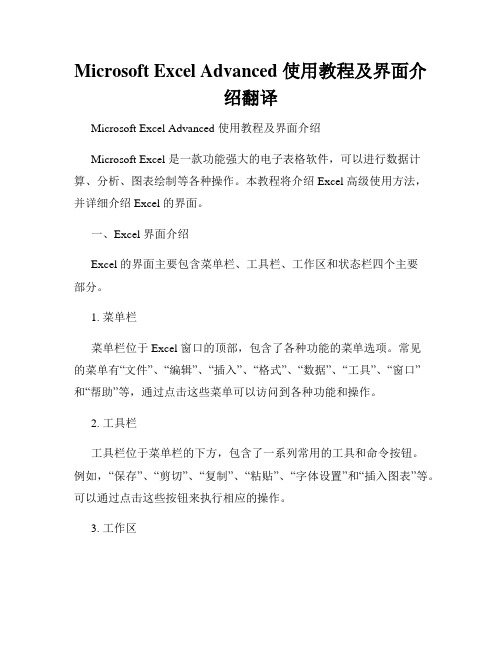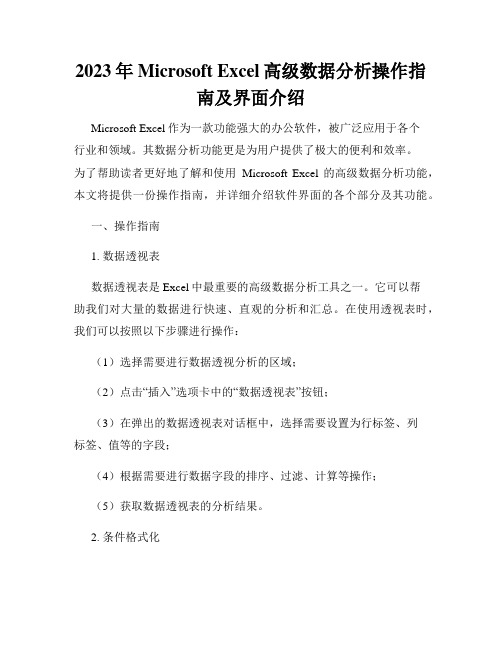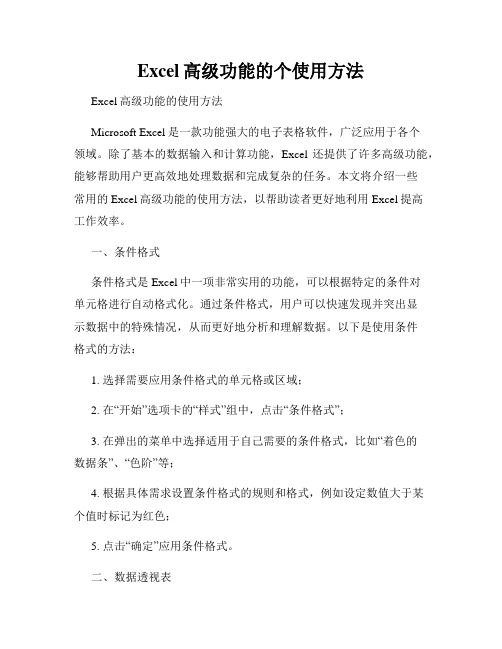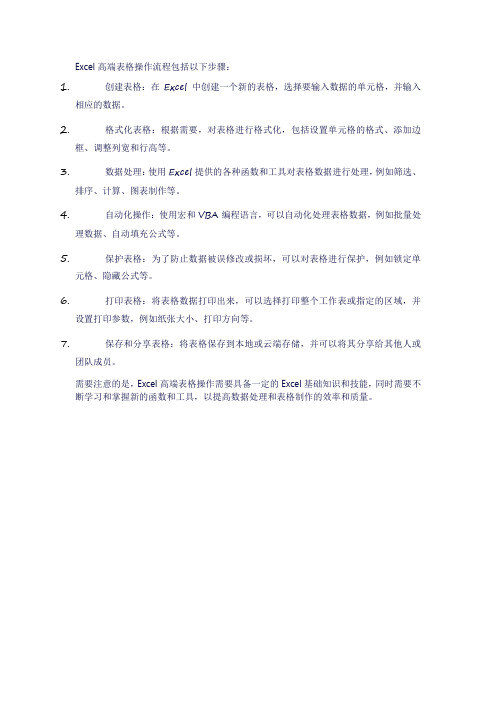2023年Microsoft Excel高级功能使用说明书
Excel软件高级功能教程

Excel软件高级功能教程第一章:数据分析与处理1.1 数据排序:介绍如何使用Excel的排序功能,对数据进行按列、按行、按特定规则排序,方便数据的查看和分析。
1.2 数据筛选:详细介绍Excel的自动筛选功能,包括按条件筛选、多条件筛选等,帮助用户从大量数据中迅速筛选出所需信息。
1.3 数据透视表:解释数据透视表的原理和用法,演示如何使用数据透视表对大量数据进行汇总分析,并生成可视化报表。
1.4 数据表关系建立:教授如何建立Excel中的数据关系,使用数据模型进行数据分析和建立关联,以达到更精准的分析结果。
第二章:函数的高级应用2.1 逻辑函数:介绍Excel中常用的逻辑函数,如IF、AND、OR等,解释其语法和应用场景,并给出实例演示。
2.2 查找与引用函数:详细阐述Excel的查找与引用函数,包括VLOOKUP、HLOOKUP、INDEX、MATCH等,演示其在数据处理中的常见应用。
2.3 统计函数:列举Excel中各类统计函数的使用方法,如SUM、AVERAGE、MAX、MIN等,教授常用统计函数的组合应用技巧。
2.4 条件函数:介绍常见的条件函数,如COUNTIF、SUMIF、AVERAGEIF等,讲解条件函数的语法和使用技巧,并给出实例说明。
第三章:图表设计与创建3.1 图表基础知识:讲解Excel图表的基本结构和类型,包括柱状图、折线图、饼图等,指导用户选择合适的图表类型。
3.2 图表创建技巧:介绍Excel中图表创建的常用技巧,如数据系列的添加、坐标轴的设置、图例的设置等,帮助用户创建美观的图表。
3.3 图表样式调整:详述Excel中图表样式的调整方法,包括填充颜色、边框样式、图表布局等,使用户能够根据需求进行图表的个性化设计。
3.4 动态图表:教授如何使用Excel的动态图表功能,通过数据的实时更新,实现图表的动态展示和数据的实时分析。
第四章:数据验证与防误操作4.1 数据验证设置:指导Excel中数据验证的使用方法,包括整数验证、日期验证和自定义验证等,确保数据的正确性。
(2024年)Excel操作技巧教程

切换工作表
通过点击工作簿底部的工 作表标签来切换不同的工 作表。
新建工作表
点击工作簿底部的新建工 作表按钮来创建新的工作 表。
5
工作簿与工作表管理
2024/3/26
重命名工作表
双击工作表标签或使用右键菜单 中的重命名选项来对工作表进行 重命名。
删除工作表
选中要删除的工作表,然后点击 右键菜单中的删除选项来删除工 作表。
柱形图
用于比较不同类别的数据大小,适用 于离散型数据。
折线图
展示数据随时间或其他因素的变化趋 势,适用于连续型数据。
2024/3/26
饼图
展示数据的占比关系,适用于分类数 据的占比展示。
散点图
展示两个变量之间的关系,适用于相 关性分析。
23
图表创建与编辑
1
创建图表
选择数据区域,点击“插入”选项卡中的图表类 型按钮,即可创建相应类型的图表。
Excel操作技巧教程
2024/3/26
1
目录
• Excel基础操作 • 数据处理与分析 • 公式与函数应用 • 图表制作与美化 • 数据可视化呈现 • 高级功能探索
2024/3/26
2
01
Excel基础操作
2024/3/26
3
工作簿与工作表管理
新建工作簿
通过快捷键Ctrl+N或点击文件菜 单中的新建选项来创建新的工作
色阶
色阶是一种通过颜色渐变来表示数据大小的方式。在Excel中,可以 为数据区域设置色阶,使得数据大小一目了然。
图标集
Excel提供了多种图标集,可以将特定的图标与单元格中的数据关联起 来,以便快速识别数据的特征和趋势。
2024/3/26
excel表格的功能和使用方法

《Excel表格的功能和使用方法》一、介绍Excel是微软推出的一款电子表格软件,它具有强大的功能和广泛的应用。
无论是在工作中处理数据,还是在日常生活中进行个人财务规划,Excel都能发挥出色的作用。
接下来,我将详细介绍Excel表格的功能和使用方法,希望能帮助大家更好地掌握这一工具。
二、基本功能1. 数据输入和编辑在Excel中,用户可以轻松输入和编辑数据,包括文字、数字、日期等各种类型的数据。
通过复制、剪切、粘贴等基本操作,可以快速完成数据的录入和修改。
2. 公式和函数Excel提供了丰富的数学、统计和逻辑公式,以及各种函数,用户可以通过这些公式和函数进行复杂的计算和数据分析。
SUM函数可以对选定的单元格范围进行求和操作,VLOOKUP函数可以实现表格数据的快速查找等。
3. 图表制作利用Excel的图表功能,用户可以将数据直观地呈现在图形化的界面上,包括柱状图、折线图、饼图等,便于用户直观地分析数据的规律和趋势。
4. 数据筛选和排序Excel提供了强大的数据筛选和排序功能,用户可以快速地根据特定条件,筛选出需要的数据,并按照指定的字段进行排序操作。
5. 数据分析和透视表通过透视表功能,用户可以方便地对大量数据进行汇总和分析,并根据不同的维度进行灵活的数据透视操作,从而发现数据背后的规律和变化。
三、高级功能1. 条件格式和数据验证通过条件格式功能,用户可以根据数据的数值大小、文字内容等条件,对单元格进行格式化,使数据的呈现更加直观和清晰。
数据验证功能可以限制数据的输入范围,减少错误数据的录入。
2. 宏和VBA编程通过宏和VBA编程,用户可以定制复杂的操作流程和功能,实现自动化的数据处理和报表生成,提高工作效率。
3. 数据连接和透视图Excel支持与数据库、网络数据源等各种数据连接方式,用户可以直接从外部数据源获取数据,并通过透视图功能进行灵活的数据分析和展现。
四、个人观点和理解作为一款电子表格软件,Excel的功能之强大远不止于此,它的应用领域涵盖了金融、会计、生产等各行各业,具有极强的通用性和灵活性。
excel2023版

excel2023版简介Excel是一款强大的电子表格软件,广泛应用于数据分析、数据处理、图表制作等领域。
excel2023版是Microsoft公司最新发布的excel版本,在功能和用户体验上有多项更新和改进。
本文将介绍excel2023版的新特性和功能以及如何使用。
新特性excel2023版引入了许多新特性,包括以下几个方面的改进:用户界面excel2023版的用户界面进行了全面优化,更加简洁清晰。
新增了自定义工具栏和快捷键功能,用户可以根据自己的需求设置自定义工具栏和快捷键,提高工作效率。
同时,excel2023版还支持多窗口操作,可以同时打开多个excel文件进行编辑。
数据分析excel2023版的数据分析功能更加强大。
新增了数据透视表和数据分析工具包,可以轻松对大量数据进行分类、汇总和分析。
同时,excel2023版还引入了自动填充功能,可以根据预测模型自动填充数据。
图表制作excel2023版提供了更多的图表类型和样式,可以满足不同需求的图表制作。
新增了3D图表和实时更新功能,可以实时展示数据变化,并通过云端载入数据,方便多人协作。
数据连接excel2023版新增了多种数据连接方式,可以方便地连接各种数据源,如数据库、网络数据等。
同时,excel2023版还加强了数据导入和导出的功能,支持各种文件格式的导入和导出。
功能介绍自定义工具栏和快捷键excel2023版提供了自定义工具栏和快捷键功能,可以根据用户的需求自定义工具栏和快捷键,方便用户快速访问常用功能。
数据透视表excel2023版的数据透视表功能更加强大,可以对大量数据进行分类、汇总和分析。
用户只需要简单设置数据透视表的字段、行、列和值,就可以快速生成各种报表和图表。
数据分析工具包excel2023版的数据分析工具包包括了常用的统计分析和数据建模工具,如回归分析、相关性分析、聚类分析等。
用户可以借助这些工具进行复杂的数据分析和建模。
Excel电子表格高级使用技巧全集文档

Excel电子表格高级使用技巧全集文档(可以直接使用,可编辑实用优质文档,欢迎下载)Excel高级使用技巧1.编辑技巧2.单元格内容的合并3.条件显示4.自定义格式5.绘制函数图象6.自定义函数7.矩阵计算8.自动切换输入法9.批量删除空行10.如何避免错误信息11.宏的使用12.图标的应用技巧1、编辑技巧1 编辑技巧(1)分数的输入如果直接输入“1/5”,系统会将其变为“1月5日”,解决办法是:先输入“0”,然后输入空格,再输入分数“1/5”。
(2)序列“001”的输入如果直接输入“001”,系统会自动判断001为数据1,解决办法是:首先输入“'”(西文单引号),然后输入“001”。
(3)日期的输入如果要输入“4月5日”,直接输入“4/5”,再敲回车就行了。
如果要输入当前日期,按一下“Ctrl+;”键。
(4)填充条纹如果想在工作簿中加入漂亮的横条纹,可以利用对齐方式中的填充功能。
先在一单元格内填入“*”或“~”等符号,然后单击此单元格,向右拖动鼠标,选中横向若干单元格,单击“格式”菜单,选中“单元格”命令,在弹出的“单元格格式”菜单中,选择“对齐”选项卡,在水平对齐下拉列表中选择“填充”,单击“确定”按钮(如图1)。
图1(5)多张工作表中输入相同的内容几个工作表中同一位置填入同一数据时,可以选中一张工作表,然后按住Ctrl键,再单击窗口左下角的Sheet1、Sheet2......来直接选择需要输入相同内容的多个工作表,接着在其中的任意一个工作表中输入这些相同的数据,此时这些数据会自动出现在选中的其它工作表之中。
输入完毕之后,再次按下键盘上的Ctrl键,然后使用鼠标左键单击所选择的多个工作表,解除这些工作表的联系,否则在一张表单中输入的数据会接着出现在选中的其它工作表内。
(6)不连续单元格填充同一数据选中一个单元格,按住Ctrl键,用鼠标单击其他单元格,就将这些单元格全部都选中了。
在编辑区中输入数据,然后按住Ctrl键,同时敲一下回车,在所有选中的单元格中都出现了这一数据。
最新excel高级使用技巧(经典版

最新excel高级使用技巧(经典版最新Excel高级使用技巧Microsoft Excel是一款广泛用于数据处理和分析、报告制作等工作的软件。
在日常工作中,我们通常只会用到Excel的基本功能,如数据输入、公式计算、图表制作等。
然而,Excel还有许多高级使用技巧,能够帮助我们提高工作效率,让数据处理更加灵活和精确。
下面是一些最新的Excel高级使用技巧,让你在使用Excel时更加得心应手。
1. 透视表:透视表是Excel强大的数据分析工具,能够帮助我们对大量数据进行汇总和分析。
在Excel中,只需选择需要汇总和分析的数据范围,然后点击"插入"选项卡中的"透视表",根据需要选择需要汇总和分析的字段,即可生成透视表。
2.数据透视图联动:在生成透视表后,我们可以使用数据透视图联动功能,将一个透视表的筛选条件应用到另一个透视表上。
只需点击透视表中的字段,然后点击“连接到数据透视图”按钮,即可实现数据透视图的联动。
3. 自动筛选:自动筛选功能能够帮助我们快速筛选数据。
在Excel 工作表中,选中需要筛选的数据范围,然后单击"数据"选项卡中的"筛选"按钮,选择需要筛选的字段和条件,即可快速筛选数据。
4. 高级筛选:高级筛选功能比自动筛选功能更加灵活和精确。
在Excel工作表中,选中需要筛选的数据范围,然后单击"数据"选项卡中的"高级"按钮,在弹出的高级筛选对话框中设置筛选条件,即可进行高级筛选。
5. 条件格式:条件格式功能能够帮助我们根据特定的条件对单元格进行格式化。
在Excel工作表中,选中需要设置条件格式的数据范围,然后单击"开始"选项卡中的"条件格式"按钮,选择需要设置的条件和格式,即可实现条件格式。
6. 数据验证:数据验证功能能够帮助我们限制单元格中的数据类型、数据范围和数据格式。
excel使用说明

excel使用说明
摘要:
1.Excel 简介
2.Excel 基本操作
3.Excel 高级功能
4.Excel 实用技巧
5.Excel 的适用场景
正文:
【Excel 简介】
Excel 是Microsoft Office 套件中的一款电子表格软件,它可以用于创建、编辑、存储和计算各种数据。
Excel 具有丰富的功能和强大的计算能力,广泛应用于家庭、学校和各种企事业单位。
【Excel 基本操作】
Excel 的基本操作包括:新建工作簿、打开和保存工作簿;选定单元格、行、列和区域;输入数据、修改数据、删除数据;复制和移动数据;查找和替换数据等。
【Excel 高级功能】
Excel 的高级功能包括:数据排序、数据筛选、数据透视表、条件格式、公式和函数等。
这些功能可以帮助用户对数据进行深入的分析和处理。
【Excel 实用技巧】
Excel 有许多实用技巧,例如:快速选择连续的单元格或区域;使用“填充”功能自动填充数据;使用“格式刷”快速复制格式;使用“条件格式”突
出显示特定数据等。
【Excel 的适用场景】
Excel 适用于各种数据处理和分析任务,例如:家庭预算管理、学生成绩记录、公司销售数据分析、市场调查数据整理等。
通过使用Excel,用户可以轻松地完成各种复杂的数据处理任务,提高工作效率。
Excel高级处理功能的使用

1.4.2 数据透视表的应用
• 本节中,将通过一个具体的示例来讲解数据透视 表的具体应用。
• 某超市的商品销售表包含以下几个字段:销售月 份、销售产品、单价、销售数量、销售总额和备 注,如图1.49所示。
1.5 使用图表统计数据
• 图表是用来将信息表示成使人容易理解的一种表 示方式。使用图表能够使人更容易理解数据统计 和计算,使得用户更加方便和快捷地操作数据。 图表能够给人以生动的感性认识,使得人们更能 够接受这种表达习惯,也就是说,人们不用怎么 动脑,就很容易理解图表所表达的数据信息。
• 下面以员工信息工作表为例,来讲解使用筛选功 能筛选数据的一些技巧,其实现的具体操作步骤 如下所示。
1.2.2 使用自定义筛选功能检索数据
• 使用筛选功能只能筛选出符合某一类条件的数据 信息,如果想要得到更加详细的信息,可以使用 自定义筛选功能来实现。
• 下面以筛选员工信息工作表中年龄在20~30之间员 工信息为例,来讲解如何实现自定义筛选的功能, 具体的操作步骤如下所示。
1.3.1 自动求和函数的使用
• 自动求和函数用于在Excel单元格中进行各种数学计算,用于自动求和中 的数据必须都是数值类型的数据信息。在Excel中,自动求和函数主要包 括以下几种。
• SUM函数:对某一行区域或列区域中的单元格数据进行求和运算。 • AVERAGE函数:对某一行区域或列区域中的单元格数据进行求平均值运算。 • MAX函数:对某一行区域或列区域中的单元格数据进行求最大值运算。 • MIN函数:对某一行区域或列区域中的单元格数据进行求最小值运算。 • 下面将具体讲解这几种函数的相关用法。
步骤如下所示。
1.4 使用数据透视表
• 前面讲解了有关数据筛选和Excel内置函数的相关 知识。在本节中,将讲解如何使用数据透视表对 Excel工作表中的数据信息进行统计和计算,重而 得到所需要的数据信息。
EXCEL2024常用的功能和技巧

格式化工作表及打印
设置单元格格式
可以设置单元格的字体、 字号、颜色、背景色、
边框等属性。
调整行高和列宽
可以根据需要调整行高 和列宽,使工作表更加
美观和易读。
添加页眉和页脚
可以在工作表的顶部和 底部添加页眉和页脚, 用于显示标题、页码等
信息。
打印输出
可以将工作表打印输出 为纸质文档或PDF文件,
方便查看和分享。
提醒用户注意宏安全性问 题,并提供相应的设置建 议,以确保数据安全。
VBA编程基础知识讲解
VBA概述
01
简要介绍VBA(Visual Basic for Applications)的基本概念、
作用和应用范围。
VBA语法基础
02
详细讲解VBA的语法规则,包括变量、数据类型、运算符、控
制结构等。
VBA常用对象和操作
03
错误预防与代码优化建议
提供一些预防错误的建议,如规范代码结构、避免使用复杂的嵌套结构
等,同时给出优化代码的建议,如使用更高效的算法、减少资源占用等。
05
CATALOGUE
协作与分享功能提升效率
共享工作簿设置及权限管理
共享工作簿
EXCEL2024支持多人同时在线编 辑一个工作簿,实现实时协作。 用户可以通过“共享工作簿”功 能,将文件上传到云端,并邀请
保护数据安全,避免误操作风险
工作簿加密保护设置方法
01
02
打开需要加密的工作簿, 选择“文件”菜单下的 “信息”选项。
点击“保护工作簿”按 钮,选择“用密码进行 加密”选项。
03
在弹出的对话框中输入 密码,并确认密码。
04
保存工作簿并关闭,重 新打开时需要输入密码 才能访问。
Microsoft Excel Advanced 使用教程及界面介绍翻译

Microsoft Excel Advanced 使用教程及界面介绍翻译Microsoft Excel Advanced 使用教程及界面介绍Microsoft Excel 是一款功能强大的电子表格软件,可以进行数据计算、分析、图表绘制等各种操作。
本教程将介绍 Excel 高级使用方法,并详细介绍 Excel 的界面。
一、Excel 界面介绍Excel 的界面主要包含菜单栏、工具栏、工作区和状态栏四个主要部分。
1. 菜单栏菜单栏位于 Excel 窗口的顶部,包含了各种功能的菜单选项。
常见的菜单有“文件”、“编辑”、“插入”、“格式”、“数据”、“工具”、“窗口”和“帮助”等,通过点击这些菜单可以访问到各种功能和操作。
2. 工具栏工具栏位于菜单栏的下方,包含了一系列常用的工具和命令按钮。
例如,“保存”、“剪切”、“复制”、“粘贴”、“字体设置”和“插入图表”等。
可以通过点击这些按钮来执行相应的操作。
3. 工作区工作区是 Excel 的主要工作区域,用于显示和编辑电子表格。
工作区由列和行组成,并以字母和数字进行标识。
用户可以在工作区上输入数据、进行计算、编辑内容、创建图表等操作。
4. 状态栏状态栏位于 Excel 窗口的底部,用于显示当前的工作状况和一些功能快捷键。
例如,状态栏常显示当前选择的单元格的位置、计数和求和值。
二、Excel 高级使用教程除了基本的数据输入和编辑功能外,Excel 还有许多高级操作和功能,可以帮助用户提高工作效率和数据处理能力。
以下是一些常用的高级功能介绍:1. 数据筛选与排序Excel 提供了筛选和排序功能,可以快速筛选出满足条件的数据和按照特定规则进行排序。
通过数据筛选和排序,用户可以更方便地分析和管理大量数据。
2. 数据透视表数据透视表是一种强大的数据分析工具,可以对大量数据进行汇总和统计。
用户可以根据需求选择并组织数据,自动生成各种数据透视表报表,并可以根据需要进行图表展示。
2023年Microsoft Excel高级数据分析操作指南及界面介绍

2023年Microsoft Excel高级数据分析操作指南及界面介绍Microsoft Excel作为一款功能强大的办公软件,被广泛应用于各个行业和领域。
其数据分析功能更是为用户提供了极大的便利和效率。
为了帮助读者更好地了解和使用Microsoft Excel的高级数据分析功能,本文将提供一份操作指南,并详细介绍软件界面的各个部分及其功能。
一、操作指南1. 数据透视表数据透视表是Excel中最重要的高级数据分析工具之一。
它可以帮助我们对大量的数据进行快速、直观的分析和汇总。
在使用透视表时,我们可以按照以下步骤进行操作:(1)选择需要进行数据透视分析的区域;(2)点击“插入”选项卡中的“数据透视表”按钮;(3)在弹出的数据透视表对话框中,选择需要设置为行标签、列标签、值等的字段;(4)根据需要进行数据字段的排序、过滤、计算等操作;(5)获取数据透视表的分析结果。
2. 条件格式化条件格式化是一种根据特定的条件对单元格进行格式设置的功能。
使用条件格式化可以让我们更好地观察和分析数据,从而发现隐藏在数据背后的规律和趋势。
下面是实施条件格式化的步骤:(1)选定需要进行条件格式化的单元格区域;(2)点击“开始”选项卡中的“条件格式化”按钮;(3)在弹出的条件格式化菜单中,选择合适的格式化规则;(4)设置符合条件的格式样式,如填充颜色、字体颜色等;(5)确认设置,观察条件格式化的效果。
3. 数据验证数据验证功能可以帮助我们对输入的数据进行有效性验证,从而减少错误和无效数据的出现。
使用数据验证时,我们可以进行以下设置:(1)选中需要设置数据验证的单元格或单元格区域;(2)点击“数据”选项卡中的“数据验证”按钮;(3)在弹出的数据验证对话框中,选择适当的验证条件,如整数、日期、列表等;(4)根据条件设置提示信息,如输入格式要求、有效数值范围等;(5)确认设置,对数据进行验证。
二、界面介绍Microsoft Excel的界面主要由以下几个部分组成:1. 菜单栏和工具栏位于Excel软件的顶部,包括常用的功能菜单和工具栏。
微软Excel SAMaRT用户指南(高级版)说明书

SAMaRT User Guide – Microsoft Excel (Advanced version)Before you start (2)Macros (2)Exploring the tool (2)Using the tool for the first time (3)Introduction page (3)Changing the drop down list options (3)Entering data into the tool (4)The Entry Form (4)Entering your data (4)Amending and deleting existing data (4)Analysing your data (5)Filtering your data (5)Pivot Tables (6)How pivot tables are set out (6)Grouping your data (7)Amending the pivot tables (8)Using the pivot table drop down lists (8)Adding a pivot table field (9)Removing a pivot table field (9)Rearranging the pivot table fields (10)Creating a new pivot table (10)Charts (11)Printing (11)Before you startSickness absence data is sensitive information. To prevent any unauthorised access to the tool, you should:a) Protect the tool with a password. On the top menu go to Tools>>Options,then the Security tab, and enter in a password in the ‘password to open’ field and press OK. It will prompt you to re-enter your password. Then save toensure the security changes are kept. The tool will now require a password to be entered any time it is opened.b) Store the files in a secure folder on your computer or network.Remember to back up your files on a regular basis, maintaining all necessary security.MacrosDepending on your computer’s security settings, you may need to change the security settings of Excel in order to be able to accept the macros that the tool uses.Go to Tools>>Options, then click on the ‘security’ tab. Then click on the ‘Macro Security’ button at the bottom of the box. You will be taken to a security box which sets out the security levels of running macros. Set this to ‘Medium’ which allows you to choose whether or not to run macros.Close Excel, and open the tool again. You should be greeted with this box if your security settings are set at ‘medium’. Press ‘Enable Macros’ as indicated by the red arrow.Exploring the toolThe tool is made up of six different worksheets.1. Instructions – this is the page that will appear each time you open the tool. Itcontains brief instructions on how to use the tool.2. Entry Form – this is the form you should use to enter information on episodesof absence in your organisation.3. Absence Record – this worksheet is where your data entered through theEntry Form is stored. Here you can amend/delete any records you haveentered. You can also enter records directly into this worksheet without using the Entry Form.4. Total Days Absence – this worksheet contains a pivot table to enable you toanalyse your sickness absence data. This pivot table shows you the totalnumber of working days absence for each employee.5. Total Absence Type – this worksheet contains another pivot table to help youto analyse your data. It shows the total number of working days absent foreach employee, organised by type of absence.6. Code Lists – this worksheet lists the codes used in the drop down listscontained in the Entry Form and Absence Records. It is possible to changethese codes to better suit your business. For more instructions on how to dothis, please see the next section.7. Troubleshooting/FAQs page – this worksheet contains condensed informationfrom this user guideUsing the tool for the first timeIntroduction pageWhen you open the Excel file, you will be greeted with the introduction page containing instructions on what to do before you start using the tool and brief user instructions on how to use the tool. We recommend you read these through carefully before you begin.Changing the drop down list optionsThe Entry Form and Absence Record worksheets use ‘drop down lists’ for some of the fields. Drop down lists contain a finite number of options to choose from, in order to make data entry easier. If you try to enter an option that is not in the drop down list, you will be greeted with an error message saying ‘the value you have entered is not valid’. The lists have already been populated and can be found under the Code Lists tab.You may wish to change the options available to you in the dropdown lists, e.g. if the job pattern options are not applicable to your business.Please note: You can only change these codes before you start entering data. Once data is entered you cannot change the codes. We recommend that before you start to enter data, you have a look at the codes to determine whether you need to make any changes. We strongly recommend that you do not change the Absence Type and Illness Categories as these are standardised fields.When you click on the Code Lists tab you will be greeted with a text box saying “Please don’t change or remove current existing categories”. This is referring to the absence type and illness categories. If you feel it would make the tool easier for you then follow these instructions:1. Find the column of categories you wish to change, and delete the optionsthat aren’t relevant to you and add your new options2. These changes will automatically be included in the ‘EntryForm’ and the‘AbsenceRecord’ drop down lists.The maximum number of options is set at what is already listed e.g. there are currently 6 options under job pattern; therefore you can only have up to 6 options of your own choosing. If you add more than 6, the extra options will not appear in the‘AbsenceRecord’ drop down lists; however they will appear in the ‘EntryForm’.You can add additional columns to the Absence Record (e.g. department); however these will not appear in the EntryForm, and so data entry will have to be done directly into the AbsenceRecord sheet. The tool has a comments field that you can use for any extra information.Entering data into the toolThe Entry FormOnce you are ready to use the tool, press the ‘EntryForm’ tab as indicated by the red arrow.The entry form contains the fields that you should fill in for each separate episode of absence. You do not have to fill out every field, but in order to gain the most complete records; we recommend that you fill out as much as possible.Entering your dataUse the ‘EntryForm’ to enter in your absence records. It is also possible to bypass the entry form and enter your data straight into the ‘AbsenceRecord’ sheet.You should ensure that the start date of absence column is always filled out correctly.Enter your employees’ names in the way you want the records to appear i.e. surname then first name, or first name then surname. The way you choose will affect the way you can sort your names.Amending and deleting existing dataIf you need to amend a record already entered, you can do this in the‘AbsenceRecord’ tab. Identify the record you wish to change and amend the required information directly in the cell.You can also delete entire records from this tab. As shown below, simply select the row you wish to delete by clicking on the row number at the very left of the screen (in the example, this is row 3). Then right click and select ‘delete’ from the options thatappear, as indicated by the red arrow below. Do not simply clear the information from the row by pressing delete on your keyboard, you need to delete the row in its entirety.Analysing your dataFiltering your dataYou can filter your data in order to see only certain information, such as an individual employee.To set up auto-filter, select all of the headings in row 1 (e.g. employee name, emp id D.O.B and so on), then go to the data menu found at the top of excel, select ‘filter’ and then ‘autofilter’ as shown below by the red arrow in the screen shot below.You should now see drop down arrows to the right of every heading as shown below. You can use these filters to show you different things.For example, you can see how many episodes of absence each employee has by pressing the filter for employee name (as shown by the red arrow) and selecting the desired name from the list, or the top 10 names that appear most often.Another example would be to select a specific illness category (column K) e.g. back problems, to see how many employees have had time off for this category.You can also use the auto-filter to sort your data (in either ascending or descending order of the column selected).This will also work if you want to sort your data while it is filtered. For example, your data is currently filtered to show only Chris’s absences, and you want to sort his absences by start date of absence. Just press the arrow next to ‘start date of absence’ and then press ‘sort ascending’.Pivot TablesThis tool uses pivot tables as a way to analyse your data. There are two pivot tables set up for you in this tool:1. Total days absence2. Total days by absence typeThe data you enter in the entry form/absence recording sheet will automatically appear in the pivot tables.Note: You need to have at least 5 episodes of absence entered before you begin to analyse your data to ensure the pivot table works correctly.How pivot tables are set outPivot tables are set out in ‘row’, ‘column’ and ‘data’ areas.1. The row areas control the data to be displayed and are the fields on the left ofthe table. They are in the red box on the screen shot below.2. The column areas also control the data to be displayed and are the fieldsrunning along the top of the table. They are in the green box on the screenshot below.3. The ‘data’ area identifies the data to be summarised and is where all thenumbers are. The area is in the yellow box on the screen shot below.It is possible to amend the pivot tables to show you something new e.g. number of days absent by job title.Hint: Save an existing pivot table in a new worksheet before amending it. This way, you will retain the original table, and have a new one already linked to the raw data that you can amend until you are happy with what it is showing you. You can create as many new worksheets as you want, so you end up with a number of different results tables showing you different things. To save in a new worksheet:1. Right click on the tab (found at the bottom of the screen) of the table you wishto copy e.g. ‘Total absence type’2. Select ‘Move or Copy’ in the options that appear3. Select where you want the sheet to appear e.g. ‘move to end’ will place thesheet last after all existing sheets4. Select ‘Create a copy’5. Rename your new sheet by right-clicking on the tab and selecting the‘rename’ option.Grouping your dataThere are various ways to group your data e.g. by month, quarter, year. The pivot tables are, as a default, grouped by month.To organise your data by another time period, right click on the ‘Start date of Absence’ field, then go to ‘Group and Show Detail’ then ‘Group’ as indicated by thescreen shot below.that will appear.You can also ungroup your data by following the above procedure, but instead ofclicking on ‘group’, click ‘ungroup’. This will cause your data to be organised byindividual start dates of absence.Amending the pivot tablesUsing the pivot table drop down listsIt is possible to amend the pivot table to show only certain types of absence. To dothis, you need to click on ‘absence type’ as indicated by the red arrow. This willprovide you with the option of choosing what absence types show up on the table.You can change this as often as you wish. The same thing can also be done for theemployees or start date of absence. Simply click ‘EmployeeName’ or ‘Start Date ofabsence’ and follow the same procedure. This will allow you to analyse the data byabsence type, or by specific employees or dates.Adding a pivot table fieldYou can change the fields of the pivot tables. To do so, first make sure the PivotTable Field List is visible. If it isn’t, simply right-click anywhere on the pivot table and select the option ‘Show Field List’, located at the bottom of the options.To add a field, e.g. Job pattern, to the row pivot table area (e.g. where the start date of absence is set out):1. select it on the PivotTable Field List; then2. select ‘Row Area’ in the drop down list at the bottom of the Field List; then3. click ‘Add to’ as indicated by the red arrowIf you want to add a field to the columns e.g. where the absence type is set out, follow the same steps but select ‘Column Area’ in the drop down list at the bottom of the Field List.The data area is different to the row and column areas and we recommend you do not add anything to this area as it may produce confusing results depending on whether the field added contains text, numbers or blank spaces.Removing a pivot table fieldIf you want to remove a field, click on the field heading (not the drop-down arrow) – in this example the absence type as indicated by the red arrow – drag back to the PivotTable Field List, as indicated by the black arrow, until a red cross appears nextto the mouse pointer, and release.Rearranging the pivot table fieldsIt is also possible to rearrange the fields. To do this, just click on the Field heading (not the drop down arrow) and drag to the desired position. A grey shaded line will appear as you drag the fields, wait until this shaded line is at the desired place and then release. For example:•You can drag the ‘EmployeeName’ field to the beginning of the pivot chart i.e.the ‘row’ area simply by dragging it onto the ‘start date of absence’ field i.e.the field currently at the beginning of the chart. The chart will now beorganised firstly by employee name, and then start date of absence.•You can also drag the fields from the row position to the column position and vice versa. From there you can rearrange them in the desired order following the above step.Creating a new pivot tableIf you want to leave the provided Pivot Tables as they are, you can create additional ones that show different trends. To create a new Pivot Table, follow the instructions below.1. Go to the ‘AbsenceRecord’ sheet2. On the Data menu, click ‘PivotTable and PivotChart Report’.3. In step 1 of the PivotTable and PivotChart Wizard, click ‘Microsoft office ExcelList or Database’, and then under ‘What kind of report do you want tocreate?’, click ‘PivotTable’.4. In step 2 of the wizard, select the ‘AbsenceRecord’ sheet and drag/highlightcolumns headings from A to S (or alternatively, you can choose to onlyinclude a certain range of columns to include in data analysis).5. In step 3 of the wizard, click ‘New Sheet’ and click Finish. This will create anew sheet with Pivot Table. Rename the new sheet.6. From here, you can drag and drop the required fields onto the pivot table.For more detailed instructions on pivot tables and how to create one please go here:/en-us/excel-help/pivottable-reports-101-HA001034632.aspx or here: /en-gb/excel-help/analyze-data-with-pivottable-reports-HA001207164.aspx?CTT=1&origin=EC001022983 ChartsIt is also possible to create a graphical representation of the data. Right-click anywhere on the Pivot Table and select the ‘PivotChart’ option. This will create a chart in a new worksheet with all the data currently shown on the Pivot Table. For example, if you were currently only looking at a specific employee’s data on the table, selecting the PivotChart option will initially create a chart showing that employees data. Once the chart has been created, however, you can alter the employees or dates that the chart shows as shown by the red arrow. You can also add or remove fields in the same way as described in the pivot table instructions above.We suggest that you print out a copy of the chart, make a note of the date on it, and then delete it within the tool. This is because it may get too unmanageable to have all the charts you have created sitting within the tool.After you have printed out the chart, dated it, and placed in a secure location, simply right click on the tab of the chart and select ‘delete’. This will delete the chart from the tool.PrintingIf you want to print out the absence records, you can hide some of the columns so that it fits more easily onto one sheet. Right click on the column headers of the columns you wish to hide, then select ‘hide’ as shown by the red arrow below. To unhide all the columns, select the whole sheet by pressing the ‘ctrl’ button and the letter ‘A’ at the same time, or by pressing the button in the top left corner of the worksheet (as shown by the red circle). Then right click anywhere on the column headers and select ‘unhide’.You can also adjust the printing margins by going to the ‘view’ menu at the top of the screen and selecting ‘page break preview’. From there, you can adjust the margins as you see fit, as shown by the red arrow. You can then go to print preview (File menu>>print preview) to see how it will look when you print it out. To go back to anormal view, simply go back to the ‘view’ menu and select ‘normal’.。
Excel高级功能的个使用方法

Excel高级功能的个使用方法Excel高级功能的使用方法Microsoft Excel是一款功能强大的电子表格软件,广泛应用于各个领域。
除了基本的数据输入和计算功能,Excel还提供了许多高级功能,能够帮助用户更高效地处理数据和完成复杂的任务。
本文将介绍一些常用的Excel高级功能的使用方法,以帮助读者更好地利用Excel提高工作效率。
一、条件格式条件格式是Excel中一项非常实用的功能,可以根据特定的条件对单元格进行自动格式化。
通过条件格式,用户可以快速发现并突出显示数据中的特殊情况,从而更好地分析和理解数据。
以下是使用条件格式的方法:1. 选择需要应用条件格式的单元格或区域;2. 在“开始”选项卡的“样式”组中,点击“条件格式”;3. 在弹出的菜单中选择适用于自己需要的条件格式,比如“着色的数据条”、“色阶”等;4. 根据具体需求设置条件格式的规则和格式,例如设定数值大于某个值时标记为红色;5. 点击“确定”应用条件格式。
二、数据透视表数据透视表是Excel中用于汇总和分析大量数据的一种功能。
通过数据透视表,用户可以迅速创建汇总报表、交叉表和可视化图表,直观地呈现数据的关系和趋势。
下面是使用数据透视表的步骤:1. 选择需要创建数据透视表的数据区域;2. 在“插入”选项卡的“表格”组中,点击“数据透视表”;3. 在弹出的对话框中,选择要分析的数据区域和放置数据透视表的位置;4. 在数据透视表字段列表中,选择需要汇总和分析的字段,如“销售额”、“日期”等;5. 拖动字段到相应的区域,如行、列、值等,以生成适合需求的汇总报表;6. 对数据透视表进行设置和样式调整,比如添加筛选条件、更改汇总方式等。
三、函数与公式Excel提供了丰富的函数与公式,可以满足各种复杂的计算和数据处理需求。
以下是几个常用的函数和公式的使用方法:1. SUM函数:用于计算一组数值的总和,例如在单元格中输入“=SUM(A1:A10)”表示计算A1到A10单元格的总和;2. IF函数:用于根据条件判断返回不同的值,例如在单元格中输入“=IF(A1>10, '满足条件', '不满足条件')”表示当A1大于10时返回“满足条件”,否则返回“不满足条件”;3. VLOOKUP函数:用于根据指定的值在表格中搜索匹配项并返回相应的值,例如在单元格中输入“=VLOOKUP(A1, B1:C10, 2, FALSE)”表示在B1到C10区域中查找A1的值,并返回第二列的值;4. CONCATENATE函数:用于将多个文本字符串合并为一个字符串,例如在单元格中输入“=CONCATENATE('Hello', ' ', 'World')”表示将“Hello”和“World”合并为一个字符串。
microsoft excel 使用手册

microsoft excel 使用手册目录1. 简介2. Excel 的界面和基本操作3. Excel 的主要功能和常用操作3.1 单元格和数据输入3.2 数据格式化3.3 公式和函数3.4 排序和筛选3.5 图表制作3.6 数据分析4. Excel 的高级功能和技巧4.1 条件格式化4.2 数据透视表4.3 宏4.4 数据连接和导入5. 结论1. 简介Microsoft Excel 是一种功能强大的电子表格软件,广泛用于数据分析、数据处理和报表制作等工作。
本手册将为您提供全面的 Excel 使用指南,帮助您熟练掌握该软件的基本操作和高级功能。
2. Excel 的界面和基本操作Excel 的界面主要由菜单栏、工具栏、工作区、公式栏和状态栏组成。
通过菜单栏和工具栏,您可以访问各种功能和命令。
工作区是您进行数据输入和编辑的主要区域。
公式栏用于输入和编辑公式,而状态栏会显示有关工作表的相关信息。
在 Excel 中,您可以使用鼠标和键盘来进行基本操作。
例如,选择单元格可以通过鼠标点击或使用上、下、左、右箭头键来完成。
使用Ctrl+C 和 Ctrl+V 快捷键可以实现复制和粘贴操作。
通过拖动单元格的边框,您可以调整它们的大小。
3. Excel 的主要功能和常用操作3.1 单元格和数据输入Excel 中的数据是存储在单元格中的。
每个单元格都有一个唯一的地址,由列字母和行号组成。
可以通过点击单元格并直接输入数据来填充单元格。
按回车键或方向键后数据将被保存。
此外,您还可以使用自动填充功能,通过拖动单元格的填充柄来快速填充一列或一行的数据。
例如,输入 1 和 2,然后选中这两个单元格并拖动填充柄,Excel 会自动填充整个序列。
3.2 数据格式化Excel 提供了各种数据格式化选项,帮助您改变数据的外观和显示方式。
您可以更改数字的小数位数、日期的格式、文本的字体和颜色等。
选择一个或多个单元格,然后右键单击选择"格式单元格",即可访问格式化选项。
excel高端表格操作流程

Excel高端表格操作流程包括以下步骤:
1.创建表格:在Excel中创建一个新的表格,选择要输入数据的单元格,并输入
相应的数据。
2.格式化表格:根据需要,对表格进行格式化,包括设置单元格的格式、添加边
框、调整列宽和行高等。
3.数据处理:使用Excel提供的各种函数和工具对表格数据进行处理,例如筛选、
排序、计算、图表制作等。
4.自动化操作:使用宏和VBA编程语言,可以自动化处理表格数据,例如批量处
理数据、自动填充公式等。
5.保护表格:为了防止数据被误修改或损坏,可以对表格进行保护,例如锁定单
元格、隐藏公式等。
6.打印表格:将表格数据打印出来,可以选择打印整个工作表或指定的区域,并
设置打印参数,例如纸张大小、打印方向等。
7.保存和分享表格:将表格保存到本地或云端存储,并可以将其分享给其他人或
团队成员。
需要注意的是,Excel高端表格操作需要具备一定的Excel基础知识和技能,同时需要不断学习和掌握新的函数和工具,以提高数据处理和表格制作的效率和质量。
轻松掌握WindowsExcel的高级功能

轻松掌握WindowsExcel的高级功能第一章:Excel的基础知识Excel是微软公司开发的一款电子表格软件,广泛应用于数据分析、统计、财务管理等领域。
为了更好地掌握Excel的高级功能,首先需要了解Excel的基础知识。
1. Excel的界面和基本操作Excel的界面包括菜单栏、工具栏、工作区等部分。
学习Excel的基本操作包括:新建、打开、保存工作簿;插入、删除、复制、移动工作表等。
2. Excel的单元格和公式Excel的工作区由许多单元格组成,每个单元格可包含数据、公式、函数等。
了解如何输入、编辑、格式化单元格数据以及编写并使用公式,是使用Excel的基本要求。
3. Excel的数据排序和筛选在Excel中,可以通过数据排序和筛选功能对大量数据进行快速整理和查找。
掌握按单列或多列排序,以及按条件筛选数据的操作,能够提高工作效率。
4. Excel的数据透视表Excel的数据透视表功能可以根据数据的特点,生成汇总报表和分析图表,便于数据分析和展示。
学会如何创建、设置和使用数据透视表,可以轻松实现复杂数据的分析。
第二章:Excel的高级公式与函数公式和函数是Excel的重要组成部分,掌握并善于运用各种高级公式与函数,能够提高工作效率和数据处理能力。
1. 条件函数的应用Excel的条件函数包括IF函数、AND函数、OR函数等。
了解条件函数的语法和用法,可以根据不同条件实现数据的判断和处理。
2. 文本函数的应用Excel的文本函数包括CONCATENATE函数、LEFT函数、RIGHT函数等。
学会使用文本函数可以快速处理文本字符串,如合并文本、提取文本等。
3. 日期和时间函数的应用Excel的日期和时间函数包括NOW函数、DATE函数、YEAR函数等。
运用日期和时间函数,可以进行日期的计算、提取日期信息等操作。
4. 统计函数的应用Excel的统计函数包括AVERAGE函数、SUM函数、COUNT函数等。
- 1、下载文档前请自行甄别文档内容的完整性,平台不提供额外的编辑、内容补充、找答案等附加服务。
- 2、"仅部分预览"的文档,不可在线预览部分如存在完整性等问题,可反馈申请退款(可完整预览的文档不适用该条件!)。
- 3、如文档侵犯您的权益,请联系客服反馈,我们会尽快为您处理(人工客服工作时间:9:00-18:30)。
2023年Microsoft Excel高级功能使用说明书
一、前言
Microsoft Excel作为一款强大的电子表格软件,具备许多高级功能,能够提高工作效率和数据分析能力。
本说明书旨在向用户介绍2023年Microsoft Excel的高级功能的使用方法与技巧。
二、数据筛选与排序
1. 数据筛选
在Excel中,可以通过数据筛选功能对大量数据进行快速筛选,以
便精确地找到所需的信息。
在“数据”选项卡中,点击“筛选”按钮,选择需要条件筛选的列,输入筛选条件并确认即可进行数据筛选。
2. 数据排序
Excel的数据排序功能可以将数据按照特定的条件进行排序,以便
更好地理清数据结构和关系。
在“数据”选项卡中,点击“排序”按钮,选择需要排序的列以及排序顺序,确认后即可进行数据排序。
三、数据透视表
1. 创建数据透视表
数据透视表是Excel中用于汇总和分析大量数据的重要工具。
选中
数据区域后,点击“插入”选项卡中的“数据透视表”按钮,选择需要汇总的字段和汇总方式,即可创建数据透视表。
2. 数据透视表筛选与排序
通过数据透视表的筛选和排序功能,可以从海量数据中更加准确地提取所需信息。
在数据透视表中,点击“下拉箭头”选择需要筛选的字段,输入筛选条件并确认即可进行数据筛选。
同时,通过单击行字段或列字段的下拉箭头,可以实现对数据透视表的排序。
四、条件格式设置
通过条件格式设置,可以根据数据的特定条件,以不同的颜色或图标显示数据的不同情况,以便更好地观察和分析数据。
在“开始”选项卡中,点击“条件格式”按钮,选择需要设置的条件格式类型,输入条件和格式内容,然后确认即可进行条件格式设置。
五、函数与公式
1. 常用函数
Excel提供了丰富的函数,可以满足各类计算需求。
常用函数包括求和、平均值、最大值、最小值等,通过在单元格中输入函数名称和参数,即可进行相应的计算。
2. 自定义函数
对于特殊的计算需求,可以使用Excel的自定义函数来满足。
在Visual Basic for Applications (VBA)编辑器中编写自定义函数,并在Excel中调用使用,可以灵活地进行数据计算和处理。
六、宏录制与应用
1. 录制宏
通过录制宏可以将一系列操作自动化,提高工作效率。
在“开发人员”选项卡中,点击“录制宏”按钮,进行需要自动化的操作,然后点击“停止录制”即可生成宏。
2. 宏应用
录制好宏后,可以将其应用于其他数据相似的工作中。
在“开发人员”选项卡中,点击“宏”按钮,选择需要执行的宏并运行即可,从而减
少重复性操作和节省时间。
七、图表制作
在Excel中,通过图表功能可以直观地展示和分析数据。
选中需要
制作图表的数据区域,点击“插入”选项卡中的“图表”按钮,选择适合的图表类型,即可创建图表,并进行样式和数据的设置。
八、数据保护与共享
Excel提供了数据保护和共享功能,可以保护数据的安全性和实现
协同工作。
通过“审阅”选项卡中的“保护工作表”和“工作簿共享”等功能,可以设定密码、权限和共享方式,以实现对数据的有效保护与高效共享。
结语
本说明书简要介绍了2023年Microsoft Excel的高级功能的使用方
法与技巧,包括数据筛选与排序、数据透视表、条件格式设置、函数
与公式、宏录制与应用、图表制作以及数据保护与共享。
希望通过本说明书的指导,用户能够更好地利用Excel的高级功能,提高工作效率和数据分析能力。
祝您使用愉快!。
